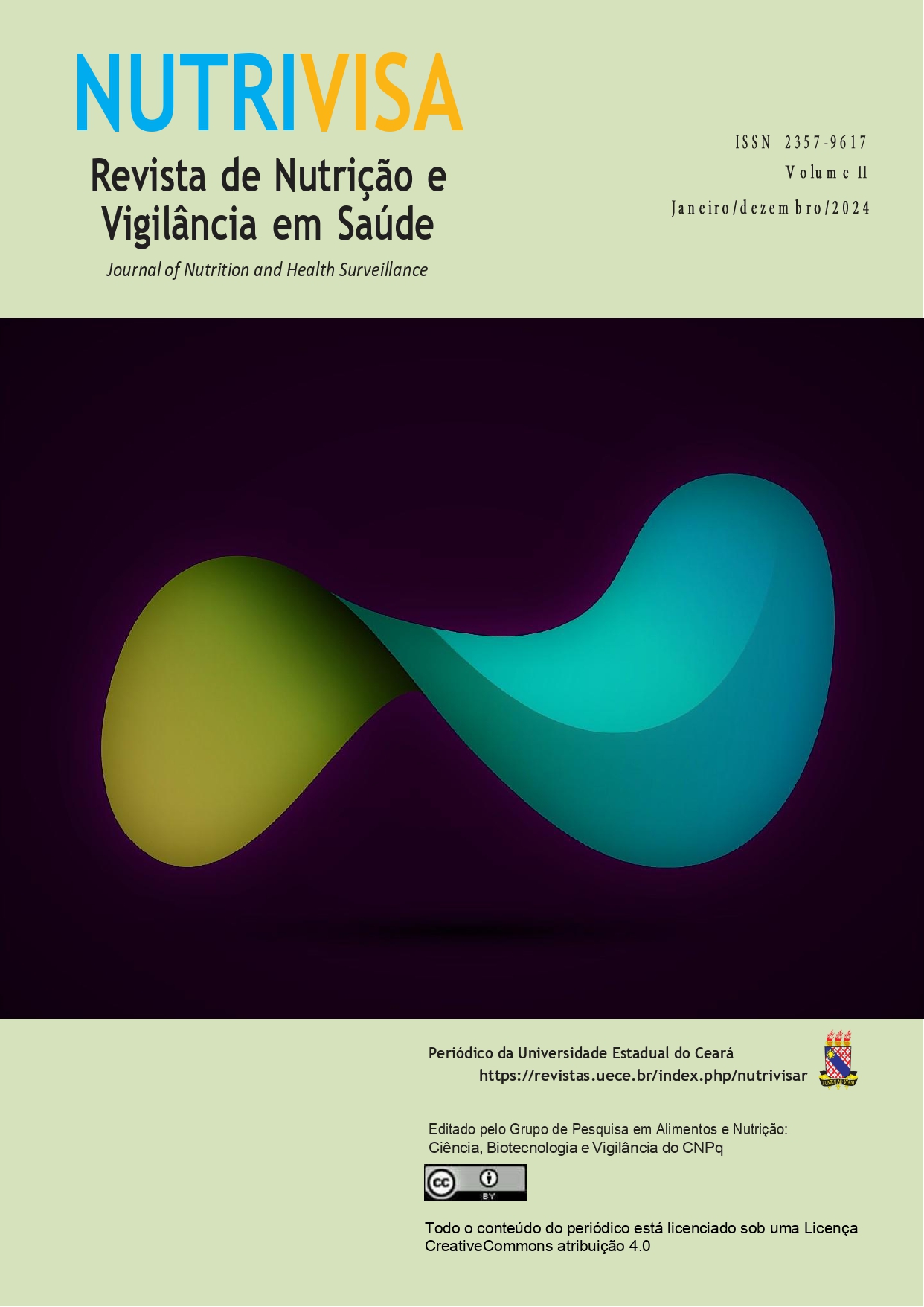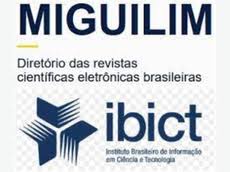Adequação calórica-proteica da terapia nutricional dos pacientes com lesão por pressão em terapia nutricional enteral exclusiva
DOI:
https://doi.org/10.52521/nutrivisa.v11i1.13669Palabras clave:
úlcera por pressão; nutrição enteral; ferimentos e lesões; Centros de Traumatologia.Resumen
As lesões por pressão (LPP) são um grave problema de saúde pública que afeta pacientes hospitalizados. O fornecimento de uma terapia nutricional adequada contribui para a prevenção e o tratamento dessas lesões. O objetivo do estudo é avaliar a adequação calórica-proteica da terapia nutricional em pacientes vítimas de trauma com lesão por pressão em terapia nutricional enteral exclusiva. A amostra foi composta por 99 pacientes com diagnóstico de trauma, dos quais 35 possuíam LPP. Foram coletadas informações clínicas, antropométricas e dietoterápicas dos participantes, e os dados foram submetidos a testes de associação e comparação de médias. Para análise da adequação proteica e calórica da dieta, verificou-se a associação entre terapia nutricional adequada e inadequada, segundo as recomendações para LPP, e os estágios da lesão. Os dados foram analisados utilizando o programa Statistical Package for the Social Sciences, considerando o nível de significância p>0,05. Em relação à terapia nutricional, encontrou-se maior prevalência de adequação proteica na dieta dos pacientes com estágios 1 e 2 de LPP em comparação com o estágio 3 e 4 (p=0,011). Contudo, sobre as calorias, não houve associação entre a adequação e os estágios. A maioria dos pacientes com LPP apresentava diagnóstico de desnutrição (80%) de acordo com a Circunferência do Braço (CB), com diferença estatística em relação aos pacientes sem LPP (p=0,018). Foi constatado maior prevalência de adequação da proteína ofertada na dieta nos pacientes com estágio 1 e 2 da lesão. Porém, a adequação das calorias da dieta não apresenta relação com os estádios da lesão.
Citas
ANDRADE, C. C. D.; RIBEIRO, A. C.; CARVALHO, C.A.S.; RUAS, C.M.; BORGES, E.L. Ocorrência de úlcera por pressão e perfil epidemiológico e clínico dos pacientes internados em uma unidade hospitalar da Fundação Hospitalar de Minas Gerais. Rev Med Minas Gerais, v. 28, n. 5, p. 1-11, 2018. doi: https://dx.doi.org/10.5935/2238-3182.20180132
BLACKBURN, G. L.; THORNTON, P. A. Nutritional assessment of the hospitalized patient. J Med Clin North Am, v. 63, n. 5, p. 1103-15, 1979.
CHUMLEA, W. C.; ROCHE, A. F.; STEINBAUGH, M. L. Estimating stature from knee height for persons 60 to 90 years of age. J Am Geriatr Soc, v. 33, p. 116-20, 1985.
DIJKINK, S.; MEIER, K.; KRIJNEN, P.; YEH, D. D.; VELMAHOS, G. C.; SCHIPPER, I. B. Malnutrition and its effects in severely injured trauma patients. Eur J Trauma Emerg Surg, v. 46, n. 5, p. 993-1004, out. 2020. doi: https://doi.org/10.1007/s00068-020-01304-5
DEMLING, R. H. Nutrition, anabolism, and the wound healing process: an overview. Eplasty, v. 9, p. e9, 2009.
DOLEY, J. Enteral Nutrition Overview. Nutrients, v. 14, n. 11, p. 2180, 24 maio 2022. doi: https://doi.org/10.3390/nu14112180
FREITAS, M. M. T.; STANICH, P.; DICCINI, S. Status and nutritional therapy in elective and emergency neurosurgery patients. Rev Bras Enferm [Internet], v. 72, n. 1, p. 73-80, 2019. doi: https://doi.org/10.1590/0034-7167-2017-0491
FRISANCHO, A. R. New norms of upper limb fat and muscle areas for assessment of nutritional status. The American Journal of Clinical Nutrition, v. 34, n. 11, p. 2540-45, 1981.
HAM, H. W.; SCHOONHOVEN, L. L.; SCHUURMANS, M. M.; LEENEN, L. L. Pressure ulcer development in trauma patients with suspected spinal injury; the influence of risk factors present in the Emergency Department. Int Emerg Nurs, v. 30, p. 13-19, 2017. doi: https://doi.org/10.1016/j.ienj.2016.05.005
IIZAKA, S.; KAITANI, T.; NAKAGAMI, G.; SUGAMA, J.; SANADA, H. Clinical validity of the estimated energy requirement and the average protein requirement for nutritional status change and wound healing in older patients with pressure ulcers: A multicenter prospective cohort study. Geriatrics & gerontology international, v.15, n.11, e1201-9, 2015. doi: http://doi.org/10.1111/ggi.12420
JOMAR, R. T. et al. Incidência de lesão por pressão em unidade de terapia intensiva oncológica. Rev. Bras. Enferm [Internet], v. 72, n. 6, p. 1490-1495, 2019. doi: http://doi.org/10.1590/0034-7167-2018-0356
KAHL, K.; FIATES, G. M. R.; NASCIMENTO, A. B. Indicadores do estado nutricional em pacientes acometidos por Lesão por Pressão em um Hospital Universitário no sul do Brasil. R. Assoc. bras. Nutr, v.12, n.4, p. 67-87, 2021. doi: https://doi.org/10.47320/rasbran.2021.1795
LAHMANN, N.; MAYER, M. F.; POSNETT, J. Pressure ulcers in German hospitals: Analysis of reimbursement and length of stay. Open Med, v. 19, n. 1, p. 20230839, 13 fev. 2024. doi: http://doi.org/10.1515/med-2023-0839
LITCHFORD, M. D. Putting the 2019 Nutrition Recommendations for Pressure Injury Prevention and Treatment into Practice. Adv Skin Wound Care, v. 33, n. 9, p. 462-68, 2020. doi: http://doi.org/10.1097/01.ASW.0000688412.05627.96
LIU, P.; SHEN, W.; CHEN, H. The Incidence of Pressure Ulcers in the Emergency Department: A Metaanalysis. Wounds, v. 29, n. 1, p. 14–19, 2017.
MONTALCINI, T.; MORACA; M.; FERRO, Y.; ROMEO, S.; SERRA, S.; RASO, M. G.; ROSSI, F.; SANNITA, W. G.; DOLCE, G.; PUJIA, A. Nutritional parameters predicting pressure ulcers and short-term mortality in patients with minimal conscious state as a result of traumatic and non-traumatic acquired brain injury. J Transl Med, n.13, p.305, 2015. doi: 10.1186/s12967-015-0660-4.
MUNOZ, N.; POSTHAUER, M. E.; CEREDA, E.; SCHOLS, J. M. G. A.; HAESLER, E. The Role of Nutrition for Pressure Injury Prevention and Healing: The 2019 International Clinical Practice Guideline Recommendations. Adv Skin Wound Care, v. 33, n. 3, p. 123-136, 2020. doi: http://doi.org/10.1097/01.ASW.0000653144.90739.ad
MUNOZ, N.; LITCHFORD, M.;, COX, J., NELSON, J.L., NIE, A.M.; DELMORE, B. Malnutrition and Pressure Injury Risk in Vulnerable Populations: Application of the 2019 International Clinical Practice Guideline. Adv Skin Wound Care, v.35, n.3, p.156-165, 2022. doi:10.1097/01.ASW.0000816332.60024.05
NELOSKA, L.; DAMEVSKA, K.; NIKOLCHEV, A.; PAVLESKA, L.; PETRESKA-ZOVIC, B.; KOSTOV, M. The Association between Malnutrition and Pressure Ulcers in Elderly in Long-Term Care Facility. Open Access Maced J Med Sci, v. 4, n. 3, p. 423-427, 2016. doi: http://doi.org/10.3889/oamjms.2016.094
NPUAP, Pressure Ulcer Stages Revised [Internet]. Washington: National Pressure Ulcer Advisory Panel (2019). Acesso em: 25.03.24. Disponível em: https://static1.squarespace.com/static/6479484083027f25a6246fcb/t/647dc6c178b260694b5c9365/1685964483662/Quick_Reference_Guide-10Mar2019.pdf.
OTTO, C.; SCHUMACHER, B.; WIESE, L.P.L.; FERRO, C.; RODRIGUES, R.A. Fatores de risco para o desenvolvimento de lesão por pressão em pacientes críticos. Enferm. Foco [Internet], v. 10, n. 1, p. 07-11, 2019.
PEEV, M. P.; YEH, D. D.; QURAISHI, S. A.; OSLER, P.; CHANG, Y.; GILLIS, E.; ALBANO, C. E.; DARAK, S.; VELMAHOS, G. C. Causes and Consequences of Interrupted Enteral Nutrition: A Prospective Observational Study in Critically Ill Surgical Patients. JPEN J Parenter Enteral Nutr, v. 39, n. 1, p. 21-27, 2015. doi: http://doi.org/10.1177/0148607114526887
QIN, Z.; WANG, Y.; ZHAO, W.; ZHANG, Y.; TIAN, Y.; SUN, S.; LI, X. Pressure ulcer healing promoted by adequate protein intake in rats. Exp Ther Med, v. 15, n. 5, p. 4173-4178, 2018. doi: http://doi.org/10.3892/etm.2018.5934
RITTER, C. G.; MEDEIROS, I. M. S.; PÁDUA, C. S.; GIMENES, F. R. E.; PRADO, P. R. Fatores de risco para a inadequação proteico-calórica em pacientes de unidade de terapia intensiva. Rev. bras. ter. intensiva [Internet], v. 31, n. 4, p. 504-510, 2019. doi: https://doi.org/10.5935/0103-507X.20190067
SAGHALEINI, S. H.; DEHGHAN, K.; SHADVAR, K.; SANAIE, S.; MAHMOODPOOR, A.; OSTADI, Z. Pressure Ulcer and Nutrition. Indian J Crit Care Med, v. 22, n. 4, p. 283-289, 2018. doi: https://doi.org/10.4103/ijccm.IJCCM_277_17
SHIFERAW, W. S.; AKALU, T. Y.; MULUGETA, H.; AYNALEM, Y. A. The global burden of pressure ulcers among patients with spinal cord injury: a systematic review and meta-analysis. BMC Musculoskelet Disord, v. 21, n. 1, p. 334, 2020. doi: https://doi.org/10.1186/s12891-020-03369-0
SERPA, L. F.; OLIVEIRA, A. S.; NOGUEIRA, P. C.; DE GOUVEIA SANTOS, V. L. C. Risk for undernutrition and development of pressure injury in hospitalised patients in Brazil: Multicentre prospective cohort study. Int Wound J, v. 17, n. 4, p. 916-924, ago. 2020. doi: https://doi.org/10.1111/iwj.13352
STECHMILLER, J. Wound healing. In: MUELLER, C. (Ed.). A.S.P.E.N. Adult Nutrition Support Core Curriculum. 2 ed. Silver Springs, MD: American Society for Parenteral and Enteral Nutrition, 2012.
TSAOUSI, G.; STAVROU, G.; IOANNIDIS, A.; SALONIKIDIS, S.; KOTZAMPASSI, K. Pressure ulcers and malnutrition: results from a snapshot sampling in a university hospital. Med Princ Pract, v.24, n.1, p.11-6, 2015. doi: https://doi.org/10.1159/000368360.
WENZEL, F.; WHITAKER, I.Y. Relationship between nutritional goals and pressure injuries in critical care patients receiving enteral nutrition. Journal of wound care, v. 33, n. 4, p. 271–277, 2024. doi:https://doi.org/10.12968/jowc.2024.33.4.271
WOO, H.Y.; OH, S.Y.; LIM, L.; IM, H.; LEE, H.; RYU, H.G. Efficacy of nutritional support protocol for patients with pressure ulcer: comparison of before and after the protocol. Nutrition, v.99, e111638, 2022. doi: https://doi.org/10.1016/j.nut.2022.
WORLD HEALTH ORGANIZATION (WHO). Physical status: the use and interpretation of anthropometry. Geneve, 1995. p. 452.
Descargas
Publicado
Cómo citar
Número
Sección
Licencia
Derechos de autor 2024 Thaynan dos Santos Dias, Luis Felipe Nunes de Oliveira, Matheus Aragão Dias Firmino, Kelly da Silva Sales, Ashley Brito Valentim, Letícia Maria Colares Perez , Ayana Florêncio de Meneses

Esta obra está bajo una licencia internacional Creative Commons Atribución 4.0.













